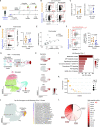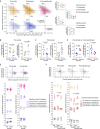This is a preprint.
Inflammation durably imprints memory CD4+ T cells
- PMID: 36415470
- PMCID: PMC9681040
- DOI: 10.1101/2022.11.15.516351
Inflammation durably imprints memory CD4+ T cells
Update in
-
SARS-CoV-2 inflammation durably imprints memory CD4 T cells.Sci Immunol. 2024 Jun 21;9(96):eadj8526. doi: 10.1126/sciimmunol.adj8526. Epub 2024 Jun 21. Sci Immunol. 2024. PMID: 38905326 Free PMC article.
Abstract
Adaptive immune responses are induced by vaccination and infection, yet little is known about how CD4+ T cell memory differs when primed in these two contexts. Notably, viral infection is generally associated with higher levels of systemic inflammation than is vaccination. To assess whether the inflammatory milieu at the time of CD4+ T cell priming has long-term effects on memory, we compared Spike-specific memory CD4+ T cells in 22 individuals around the time of the participants' third SARS-CoV-2 mRNA vaccination, with stratification by whether the participants' first exposure to Spike was via virus or mRNA vaccine. Multimodal single-cell profiling of Spike-specific CD4+ T cells revealed 755 differentially expressed genes that distinguished infection- and vaccine-primed memory CD4+ T cells. Spike-specific CD4+ T cells from infection-primed individuals had strong enrichment for cytotoxicity and interferon signaling genes, whereas Spike-specific CD4+ T cells from vaccine-primed individuals were enriched for proliferative pathways by gene set enrichment analysis. Moreover, Spike-specific memory CD4+ T cells established by infection had distinct epigenetic landscapes driven by enrichment of IRF-family transcription factors, relative to T cells established by mRNA vaccination. This transcriptional imprint was minimally altered following subsequent mRNA vaccination or breakthrough infection, reflecting the strong bias induced by the inflammatory environment during initial memory differentiation. Together, these data suggest that the inflammatory context during CD4+ T cell priming is durably imprinted in the memory state at transcriptional and epigenetic levels, which has implications for personalization of vaccination based on prior infection history.
Conflict of interest statement
Declaration of Interests MJM reported potential competing interests: laboratory research and clinical trials contracts with Lilly, Pfizer (exclusive of the current work), and Sanofi for vaccines or MAB vs SARS-CoV-2; contract funding from USG/HHS/BARDA for research specimen characterization and repository; research grant funding from USG/HHS/NIH for SARS-CoV-2 vaccine and MAB clinical trials; personal fees from Meissa Vaccines, Inc. and Pfizer for Scientific Advisory Board service. RSH has received research support from CareDx for SARS-CoV-2 vaccine studies and has performed consulting work for Bristol-Myers-Squib.
Figures






References
-
- Tan A.T., Linster M., Tan C.W., Le Bert N., Chia W.N., Kunasegaran K., Zhuang Y., Tham C.Y.L., Chia A., Smith G.J.D., et al. (2021). Early induction of functional SARS-CoV-2-specific T cells associates with rapid viral clearance and mild disease in COVID-19 patients. Cell Rep. 34, 108728. - PMC - PubMed
-
- Plotkin S.A. (2020). Updates on immunologic correlates of vaccine-induced protection. Vaccine 38, 2250–2257. - PubMed
Publication types
Grants and funding
LinkOut - more resources
Full Text Sources
Research Materials
Miscellaneous
